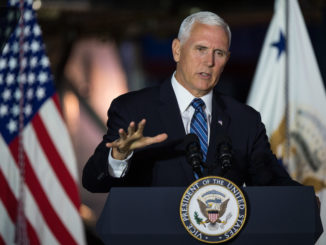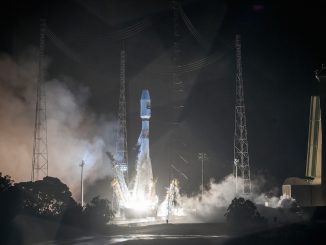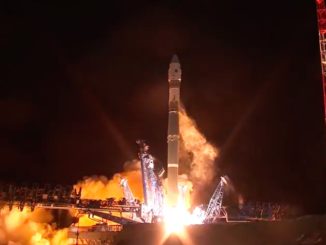
An unpiloted Russian Soyuz spacecraft, carrying a humanoid robot instead of cosmonauts, parachuted to a rare nighttime landing on the steppe of Kazakhstan Friday (U.S. time) to wrap up a test flight to the International Space Station that paved the way for crewed launches using upgraded Soyuz boosters next year.
The 16-day test flight, which launched Aug. 22, also demonstrated technology Russia aims to use on a future automated payload return vehicle to bring cargo and experiments back to Earth.
The Soyuz MS-14 spacecraft’s descent module landed in a rural zone of south-central Kazakhstan at 2132 GMT (5:32 p.m. EDT) Friday, or 3:32 a.m. local time Saturday at the landing site, according to Roscosmos, the Russian space agency.
The spacecraft brought Russia’s Skybot F-850 robot back to Earth after completing a series of tests with Russian cosmonauts on the space station.
The Soyuz MS-14 spacecraft arrived at the station Aug. 26, three days after a dramatic docking abort caused by a faulty amplifier in the automated rendezvous system on the space station’s Poisk docking port.
Russian cosmonaut Alexander Skvortsov and two crewmates repositioned their Soyuz MS-13 capsule to Poisk in a manual maneuver to clear the way for the Soyuz MS-14 spacecraft to try another automated approach to the aft port of the station’s Zvezda module.
The second rendezvous went according to plan.
The station crew opened hatches leading to the Soyuz MS-14 spacecraft and unpacked some 1,450 pounds (657 kilograms) of equipment inside the ship.
One of the experiments delivered by the Soyuz was a two-legged, two-armed humanoid robot named Skybot F-850.
Under the supervision of Skvortsov and cosmonaut Alexey Ovchinin, Skybot F-850 completed a series of technological experiments on the station over the last week-and-a-half.
Measuring nearly 6 feet (1.8 meters) tall and weighing about 350 pounds (160 kilograms), Skybot F-850 is an evolution of Russia’s FEDOR series of robots, which engineers originally developed for rescue operations. Videos from ground testing have shown the FEDOR robot shooting guns, lifting weights and driving a car.
The robot can replicate the movements of a human operator, and Skybot F-850 successfully connected cables and worked with tools used by cosmonauts on spacewalks outside the station, according to Roscosmos. A video released by Roscosmos showed Skvortsov wearing virtual reality head gear to provide inputs to the robot.
Russia could launch future upgraded robots that could work outside the space station, helping crews with tasks on spacewalks, or allowing cosmonauts to avoid spacewalks altogether, according to Alexander Bloshenko, a science advisor at Rosccosmos.
The Russian Foundation for Advanced Research Projects, with a role similar to DARPA in the U.S. government, led the development of the FEDOR robot. FEDOR stands for Final Experimental Demonstration Object Research.
Так я пытался состыковать электросоединители. Эта операция входит в перечень операций в рамках внекорабельной деятельности. Зачёт pic.twitter.com/yOYqc32Eas
— FEDOR (@FEDOR37516789) August 31, 2019
A Twitter account set up for the space robot included updates from Skybot F-850’s perspective throughout the mission, including videos and images of it looking out the space station’s window and conducting demonstrations with Skvortsov and Ovchinin.
The robot launched in the center seat of the Soyuz MS-14 spacecraft, and the station crew strapped Skybot F-850 into the same seat for Friday’s undocking and landing.
Like the ship’s rendezvous, the departure and re-entry occurred in autopilot mode. The Soyuz MS-14 spacecraft was the first Soyuz crew ferry craft to fly without human occupants in 33 years.
Russian officials approved the unpiloted test flight to verify the Soyuz spacecraft’s compatibility with the upgraded Soyuz-2.1a launch vehicle, which will begin carrying crews into orbit next March.
The Soyuz MS-14 spacecraft also tested a modified motion control system, and a modernized digital descent control system based using fiber-optic gyroscopes to replace an old analog system with a free gyroscope.
The new re-entry control system could be used on a future Soyuz payload return vehicle that could bring heavier cargo back to Earth from the space station. Crewed Soyuz missions have a limited capacity to land with cargo and experiments.
With the Soyuz MS-14 mission complete, the space station crew is readying for the arrival of a Japanese HTV cargo ship next week.
The eighth HTV resupply mission, also known as Kounotori 8, is set for liftoff aboard an H-2B rocket from Tanegashima Island, Japan, at 2133 GMT (5:33 p.m. EDT) Tuesday, Sept. 10. The automated supply ship is scheduled to arrive at the space station Sept. 14 with more than 7,700 pounds — about 3.5 metric tons — of supplies and experiments.
Email the author.
Follow Stephen Clark on Twitter: @StephenClark1.



